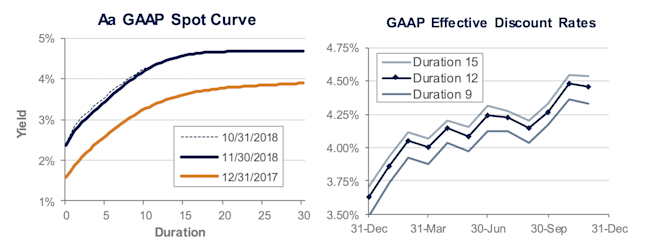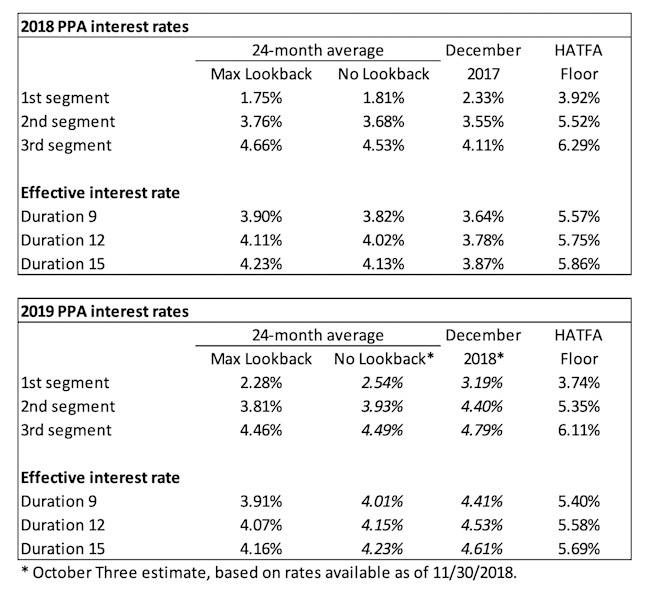November 2018 Pension Finance Update
After an awful October, pension finances stabilized in November, with both model plans we track [1] treading water during the month. Plan A eked out a fractional improvement in November and is now up 6% for the year, while the more conservative Plan B was unchanged last month and remains ahead by less than 1% through the first eleven months of 2018.
After an awful October, pension finances stabilized in November, with both model plans we track [1] treading water during the month. Plan A eked out a fractional improvement in November and is now up 6% for the year, while the more conservative Plan B was unchanged last month and remains ahead by less than 1% through the first eleven months of 2018:

Assets
November was ok for stocks: the S&P 500 gained 2%, Nasdaq was up less than 1%, the small-cap Russell 200 added more than 1%, and the overseas EAFE index gained almost 1%. For the year, the S&P 500 is up 5%, the NASDAQ is ahead 6%, and the Russell 2000 is up 1%, but the EAFE index remains down 9% during 2018.
A diversified stock portfolio added more than 1% in November and is now up 1% for the year.
Bonds gained close to 1% last month, as Treasury rates moved down more than 0.1% while credit spreads increased by almost as much, leaving corporate bond yields down just a couple basis points. Through November, a diversified bond portfolio is down 3%-5%, with long duration bonds and corporates doing worst.
Overall, our traditional 60/40 gained 1% in November and is now down 1% for the year, while the conservative 20/80 portfolio added less than 1% and is now down 4% through the first eleven months of 2018.
Liabilities
Pension liabilities (for funding, accounting, and de-risking purposes) are now driven by market interest rates. The graph on the left compares our Aa GAAP spot yield curve at December 31, 2017, and November 30, 2018, and it also shows the movement in the curve last month. The graph on the right shows our estimate of movements in effective GAAP discount rates for pension obligations of various duration during 2018:

Corporate bond yields fell a couple basis points in November, pushing pension liabilities up less than 1%. For the year, liabilities remain down 4%-8%, with long duration plans seeing the biggest drops.
Summary
2018 has been a poor year for investments, but a decent year for pension finance, as higher interest rates have shrunk the value of pension liabilities. The graphs below show the movement of assets and liabilities for our two model plans so far this year:

Looking Ahead
Congress passed a budget in 2015 that includes a third round of pension funding relief since 2012. The persistence of historically low interest rates, however, means that pension sponsors that have only made required contributions will see contributions ramp up in the next few years as the impact of relief fades (barring a continued surge in long-term rates).
Discount rates edged down modestly last month. We expect most pension sponsors will use effective discount rates in the 4.2%-4.7% range to measure pension liabilities right now.
The table below summarizes rates that plan sponsors are required to use for IRS funding purposes for 2018, along with estimates for 2019. Pre-relief, both 24-month averages and December ‘spot’ rates, which are still required for some calculations, such as PBGC premiums, are also included.

[1] Plan A is a traditional plan (duration 12 at 5.5%) with a 60/40 asset allocation, while Plan B is a largely retired plan (duration 9 at 5.5%) with a 20/80 allocation with a greater emphasis on corporate and long-duration bonds. We assume overhead expenses of 1% of plan assets per year, and we assume the plans are 100% funded at the beginning of the year and ignore benefit accruals, contributions, and benefit payments in order to isolate the financial performance of plan assets versus liabilities.
